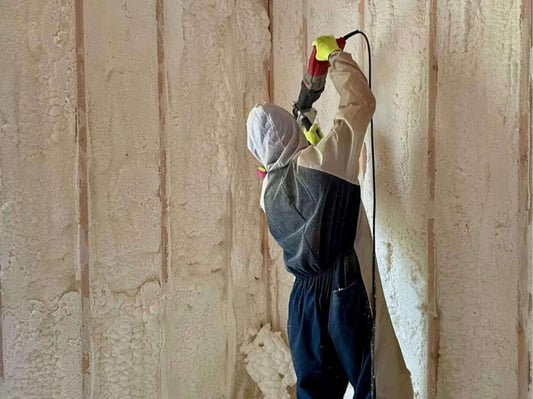
You’ve been doing more research on spray foam insulation, and you ran into the term vapor barrier. You can’t find a direct answer about what a vapor barrier is or what it is used for. You’re considering spray foam, but you want to be sure that spray foam has a vapor barrier if your home needs one.
South Central Services has installed spray foam insulation in hundreds of buildings. Vapor barriers are easily one of the most complex topics related to spray foam and building science. However, understanding vapor barriers can help you understand building science as a whole. Reading this article will not only explain the relationship between spray foam insulation and vapor barriers. This article will also empower you to determine if these products and features are necessary for your project.
By the end of this article, you will understand:
- What a vapor barrier is, and is not
- If spray foam insulation can create a vapor barrier
- When homes need vapor barriers
Don't have time to read right now? Check out everything you need to know at a glance.
What Does A Vapor Barrier Do?
To understand a vapor barrier, we first must know what vapor means. In building science, the term vapor refers to water in its gaseous state. Vapor is the water content in the air.
A vapor barrier stops vapor in the air from permeating an assembly. The goal of a vapor barrier is to keep water out and allow moisture to escape if it enters a building. A vapor barrier must be installed in the right place in an assembly based on its materials. Effective vapor barriers also depend on the climate and temperature of the building location.
Warm air can hold more vapor than cold air. When vapor moves from warm to cool air, the air becomes more saturated with vapor content. If air cannot hold any more vapor, the vapor condenses into liquid. For climates with extreme temperatures, vapor barriers can prevent water from condensing and becoming trapped inside a building assembly.
A vapor barrier is not a waterproofing product. While these barriers can stop water from permeating in its gaseous form, vapor barriers cannot stop liquid water.
Can Spray Foam Insulation Create A Vapor Barrier?
The short answer is that closed cell spray foam can create a vapor barrier, but open cell spray foam cannot. One of the reasons that spray foam is a unique insulation product is the option between rigid closed cell spray foam and less rigid open cell spray foam.
These two types of foam have different cell structures, and the cell structures dictate their physical properties.
Closed Cell Spray Foam Can Create A Vapor Barrier
With its tight cell structure and rigid composition, closed cell spray foam can create vapor barriers. At approximately 1.5 inches depth, closed cell spray foam prevents vapor from permeating.
For buildings in a cold climate, closed cell spray foam prevents the humidity in the warm inside air from entering the colder wall assembly and condensing.
For buildings in a warm climate, closed cell spray foam prevents condensation from forming in a wall assembly as warm outside air meets the cold wall assembly.

Open Cell Spray Foam Cannot Create A Vapor Barrier
Open cell spray foam has an open cell structure. No matter how much open cell spray foam is installed, it cannot create a vapor barrier on its own. Instead, for above-grade applications like roofs and attics, open cell spray foam can have added vapor retardant coatings to act as a vapor barrier.

Does My Home Need A Vapor Barrier?
The need for vapor barriers varies by climate. For our clients in Climate Zone 5, vapor barriers are either necessary or recommended for these types of applications.
Exterior Wall Assemblies
Vapor barriers are recommended for any exterior wall assembly in Climate Zone 5. The exterior walls are the barrier between conditioned inside air and the air outside the home. A vapor barrier appropriately installed in an exterior wall will prevent vapor from entering or moving through a wall assembly.

What a proper vapor barrier looks like will depend on the materials that make up the wall assembly. However, without a vapor barrier in an exterior wall, vapor can condense inside the wall or change the humidity levels inside your home. The humid summers of southern Pennsylvania are especially concerning, with high humidity air being drawn to conditioned indoor spaces.
Crawl Spaces
Crawl spaces are not only insulated, but encapsulated. Closed cell spray foam is one of several products that we use in crawl space encapsulation. Since crawl spaces are below-grade, vapor barriers are required to control the moisture content in the ground.

For residents of Adams County who are considering encapsulating their crawl spaces, you will need a vapor barrier. The vapor barrier may come from a peel-and-stick membrane, a fluid-applied barrier, or even polyethylene sheeting. Be sure to discuss vapor control with your contractor.
Masonry And Concrete Substrates
Masonry and concrete are both permeable substrates, meaning that air and vapor can pass through them. These materials transmit both vapor and temperature in a way that necessitates a vapor barrier. Vapor barriers are most commonly installed on the inner side of a masonry wall to prevent vapor from entering a structure.
Without a vapor barrier, temperature changes and vapor can force your HVAC system to work harder. Installing spray foam insulation is a good practice to keep your building more temperature regulated.
Concrete walls are commonly found in unfinished basements in Berkeley County, WV. Closed cell spray foam can prevent damp cool air from increasing the humidity in the rest of the home.

Metal Substrates
Metal is a conductive material, so it conducts temperature change well. This conductive feature of metal is not desirable for a conditioned space. Installing closed cell spray foam insulation will not only better maintain the temperature of the space but will also offer a vapor barrier.

Why would you want a vapor barrier specifically for metal surfaces? Let’s look at an example using everyday objects.
If you pull a soda can out of the fridge, it will start to condensate almost immediately. Droplets of water will form on the surface of the can. By contrast, if you pour the cold liquid from the can into a Styrofoam cup, the surface of the Styrofoam will not condensate as quickly. Having a vapor barrier prevents vapor from condensing on the surface of your substrate or your insulation.
The Bottom Line About Spray Foam Vapor Barriers
Closed cell spray foam insulation can be used to create a vapor barrier. In our climate zone, these vapor barriers are most helpful for exterior walls, concrete walls, and masonry applications.
Your home may not need a vapor barrier if you do not live in Climate Zone 5. Vapor barriers are most useful in extreme climates, so residents in climates with consistent temperatures are less likely to benefit. Be sure to discuss the possibility of vapor barriers with your insulation contractors.
Now that you know which type of spray foam can create a vapor barrier, your next step is to:
- Discover how long spray foam insulation lasts
- Learn whether or not spray foam insulation can fail
- Weigh the pros and cons of closed cell spray foam
Disclaimer: While we strive to publish information accurate to building science, local building codes and standards supersede our recommendations.
Kilian has co-owned and operated South Central Services for 8 years. He is passionate about community involvement. In his spare time, he enjoys being with his family, playing ice hockey, and going fishing with friends.
Topics:


